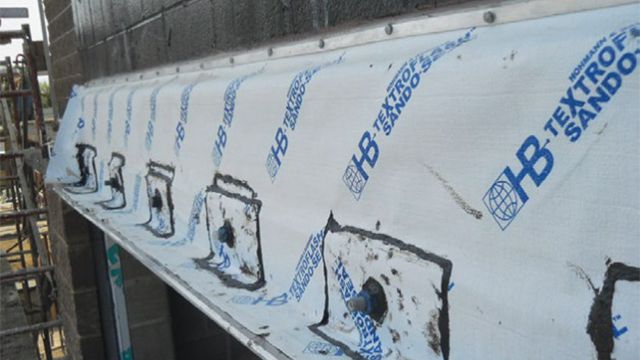Trowel Tech
Technical questions answered
By Masonry
Mason contractors across the country face similar challenges when out in the field. With the help of Hohmann and Barnard’s director of technical services, Jeremy Douglas, Masonry delivers answers to some of your most technical, complicated questions.
Q: What is the best way to go about installing a flexible flashing over a relieving angle that’s bolted to the wall?
A: Flashing details at relieving angles can be challenging because of the large structural bolts that are used to fasten the angle to the backup, which are often left protruding from the vertical face of the angle by two inches or more. While this detail may sometimes be shown in the drawings, most often it is left to decide how best to detail the condition in the field.
The primary concern is to ensure we’ve protected the integrity of the flashing material, as flexible flashings have varying degrees of puncture resistance. A typical self-adhering peel-and-stick flashing is puncture resistant to about 100 lbf (pound force), while the newer flexible stainless-steel flashings can be resistant to well over 900 lbf.
As an example, if we were to simply lay a 40 mil self-adhering membrane over the bolt’s point, the flashing will likely become damaged over time as pressure and movement forces the membrane against the point and threads, and subsequent abrasion and punctures will occur. While not ideal, it may be preferable in some cases to cut into the flashing membrane to allow for the bolts to pass through its vertical plane, then sealing around the edges of the opening and bolt with the appropriate flashing tape, mastic, or sealants.
Most flexible metal flashings can be installed without the specialized detailing around the bolts, though will sometimes be called to be detailed in the same way to allow for a rigid insulation to be installed tightly to the backup. Here, it is imperative that a compatible tape be adhered around the opening of the cut made in the flashing to prevent the metal from further tearing. Be sure that in any case where the flashing is to be punctured that you use a lot of sealant or mastic, and that it is tooled around every penetration to assure it has been sufficiently applied with good adhesion.
Q: I’ve installed self-adhering air barrier systems over steel stud and sheathing walls on several past projects. I’ve submitted the same system on a current project that is block backup and brick veneer, and am told I can only use a fluid applied air barrier. Why?
A: There are several reasons why it can be disadvantageous to use a peel-and-stick air barrier system against a concrete block backup wall. First, it is critical that the air barrier be fully adhered to the backup wall. Unlike smoother sheathings, concrete blocks have many open pores and may have granular surfaces, which make adequate adhesion difficult to achieve. Pre-application of a good primer and installing the membrane with a hard roller here is critical, and also costly.
My biggest concern, however, is continuity. In the case of a concrete block/brick veneer wall, you will likely have a pair of eyelets as part of the anchorage system sticking out of the bed joints 16 inches in any direction. This means that in just a 10- x 10-foot section of wall, you will have an additional 112 points that will require detailing to ensure continuity. Multiply this across the entirety of your project, and you will see why fluid-applied systems are much preferred.
I believe you will find fluid-applied systems and the equipment that goes with them much less labor intensive to install, and with greater continuity.
Originally published in Masonry magazine.
About the Author
Masonry, the official publication of the Mason Contractors Association of America, covers every aspect of the mason contractor profession - equipment and techniques, building codes and standards, business planning, promoting your business, legal issues and more. Read or subscribe to Masonry magazine at www.masonrymagazine.com.



















